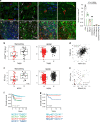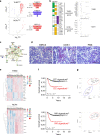Cellular and gene signatures of tumor-infiltrating dendritic cells and natural-killer cells predict prognosis of neuroblastoma
- PMID: 33239635
- PMCID: PMC7689423
- DOI: 10.1038/s41467-020-19781-y
Cellular and gene signatures of tumor-infiltrating dendritic cells and natural-killer cells predict prognosis of neuroblastoma
Abstract
Tumor-infiltrating lymphocytes play an essential role in improving clinical outcome of neuroblastoma (NB) patients, but their relationship with other tumor-infiltrating immune cells in the T cell-inflamed tumors remains poorly investigated. Here we show that dendritic cells (DCs) and natural killer (NK) cells are positively correlated with T-cell infiltration in human NB, both at transcriptional and protein levels, and associate with a favorable prognosis. Multiplex imaging displays DC/NK/T cell conjugates in the tumor microenvironment of low-risk NB. Remarkably, this connection is further strengthened by the identification of gene signatures related to DCs and NK cells able to predict survival of NB patients and strongly correlate with the expression of PD-1 and PD-L1. In summary, our findings unveil a key prognostic role of DCs and NK cells and indicate their related gene signatures as promising tools for the identification of clinical biomarkers to better define risk stratification and survival of NB patients.
Conflict of interest statement
The authors declare no competing interests.
Figures






Similar articles
-
PD-L1-expressing natural killer cells predict favorable prognosis and response to PD-1/PD-L1 blockade in neuroblastoma.Oncoimmunology. 2023 Dec 1;13(1):2289738. doi: 10.1080/2162402X.2023.2289738. eCollection 2024. Oncoimmunology. 2023. PMID: 38125723 Free PMC article.
-
High FLT3 expression increases immune-cell infiltration in the tumor microenvironment and correlates with prolonged disease-free survival in patients with non-small cell lung cancer.Mol Oncol. 2024 May;18(5):1316-1326. doi: 10.1002/1878-0261.13597. Epub 2024 Feb 7. Mol Oncol. 2024. PMID: 38327131 Free PMC article.
-
Blockage of immune checkpoint molecules increases T-cell priming potential of dendritic cell vaccine.Immunology. 2020 Jan;159(1):75-87. doi: 10.1111/imm.13126. Epub 2019 Oct 24. Immunology. 2020. PMID: 31587253 Free PMC article.
-
Prognostic and clinicopathological significance of PD-1/PD-L1 expression in the tumor microenvironment and neoplastic cells for lymphoma.Int Immunopharmacol. 2019 Dec;77:105999. doi: 10.1016/j.intimp.2019.105999. Epub 2019 Nov 6. Int Immunopharmacol. 2019. PMID: 31704289 Review.
-
Tumor immune microenvironment and immune checkpoint inhibitors in esophageal squamous cell carcinoma.Cancer Sci. 2020 Sep;111(9):3132-3141. doi: 10.1111/cas.14541. Epub 2020 Jul 14. Cancer Sci. 2020. PMID: 32579769 Free PMC article. Review.
Cited by
-
Combining ERAP1 silencing and entinostat therapy to overcome resistance to cancer immunotherapy in neuroblastoma.J Exp Clin Cancer Res. 2024 Oct 22;43(1):292. doi: 10.1186/s13046-024-03180-y. J Exp Clin Cancer Res. 2024. PMID: 39438988 Free PMC article.
-
Impaired Antitumor Immune Response in MYCN-amplified Neuroblastoma Is Associated with Lack of CCL2 Secretion and Poor Dendritic Cell Recruitment.Cancer Res Commun. 2022 Jul 5;2(7):577-589. doi: 10.1158/2767-9764.CRC-21-0134. eCollection 2022 Jul. Cancer Res Commun. 2022. PMID: 36923280 Free PMC article.
-
A signature-based classification of lung adenocarcinoma that stratifies tumor immunity.Front Oncol. 2023 Jan 12;12:1023833. doi: 10.3389/fonc.2022.1023833. eCollection 2022. Front Oncol. 2023. PMID: 36713530 Free PMC article.
-
Small extracellular vesicles induce resistance to anti-GD2 immunotherapy unveiling tipifarnib as an adjunct to neuroblastoma immunotherapy.J Immunother Cancer. 2022 Apr;10(4):e004399. doi: 10.1136/jitc-2021-004399. J Immunother Cancer. 2022. PMID: 35483745 Free PMC article.
-
Central nervous system immune interactome is a function of cancer lineage, tumor microenvironment, and STAT3 expression.JCI Insight. 2022 May 9;7(9):e157612. doi: 10.1172/jci.insight.157612. JCI Insight. 2022. PMID: 35316217 Free PMC article.
References
Publication types
MeSH terms
Substances
Grants and funding
LinkOut - more resources
Full Text Sources
Medical
Research Materials

